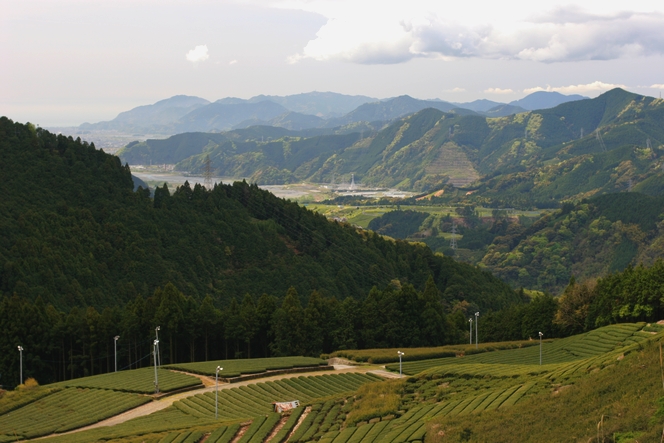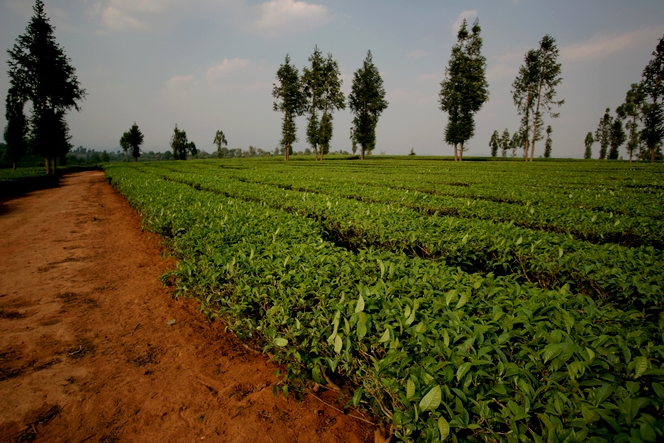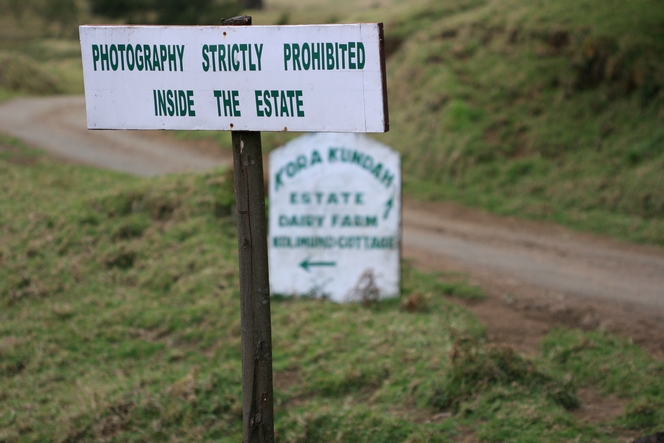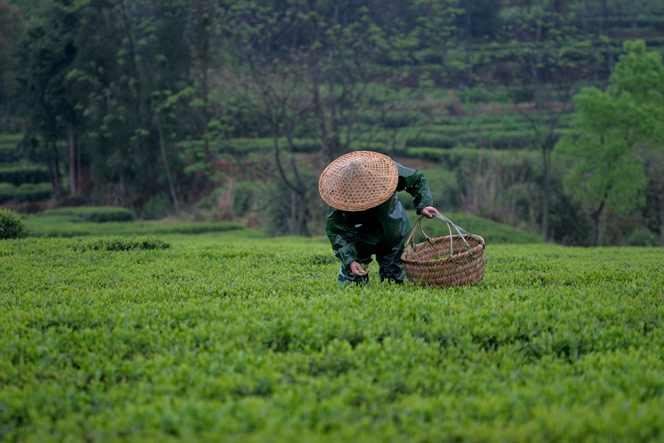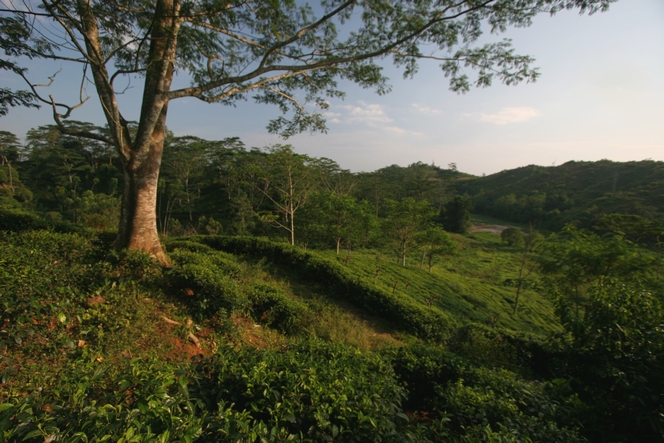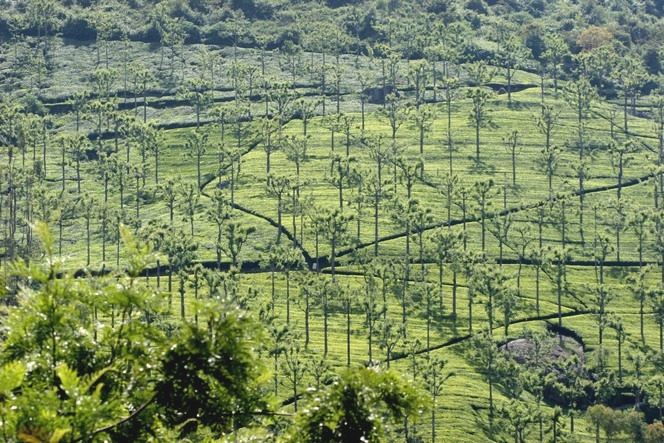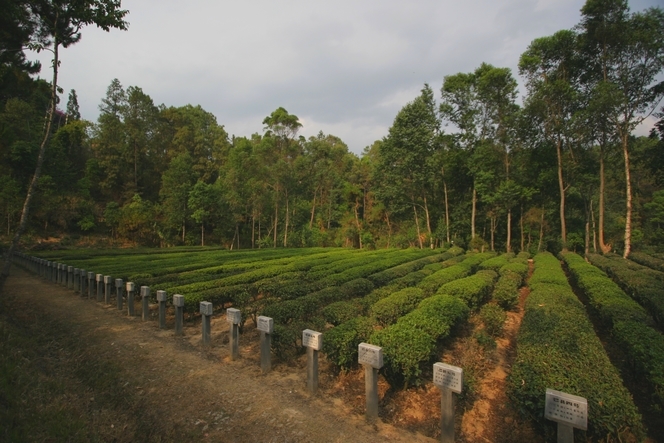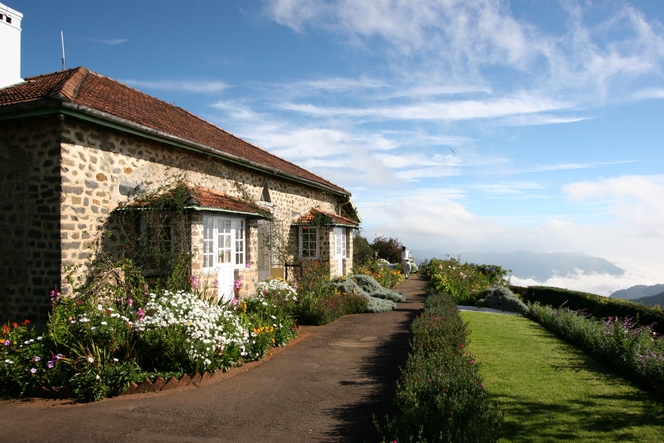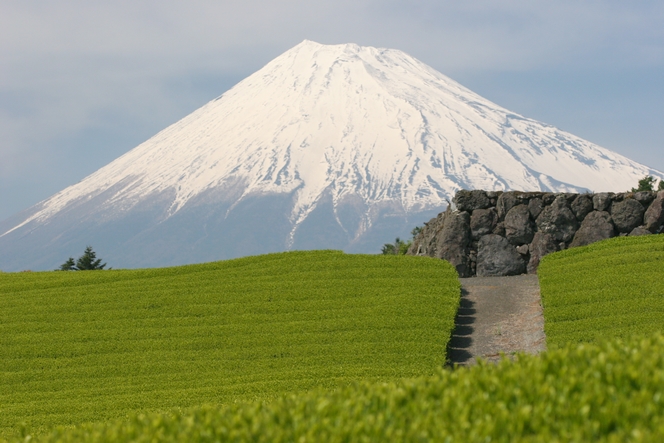At New Vithanakande (in the south of Ratnapura, Sri Lanka), to keep the tea plants at the right height, the trees serve as a kind of traffic light system: if you see green, the tea plant is not too high, if the green disappears it is the orange that shows, and the plants need to be cut lower, and if only the red shows, things have got out of hand!
Plantation
In Japan, the harvests of tea are also delayed
These days I was nearby Shizuoka, the main tea producing region of Japan. I took this picture in Tawaramine, a highly considered place for growing tea. Beyond the harmonious curve made by the row of tea trees, one can see the city of Shizuoka spreading out on the border of the Pacific.
The farmers of Tawaramine, just like the ones of the other surrounding mountains (Asahina, Hirayama…), don’t have much to complain this year. The harvesting of tea is of course very much delayed this year due to the cold weather of April and the shoots are only beginning to show up. However they do not have to experience the disaster of their colleagues located on the Makinohara plateau: because of a lower altitude and an early spring followed by a rough cold snap, the tea trees have simply frozen, and as a result the production of tea is partly compromised for them.
So from Darjeeling to Shizuoka, from Yunnan to Anhui and from Zhejiang to Fujian, the harvests are really delayed this year.
The earth of origin of the Grand Yunnan Imperial
Yunnan is known for its red earth, which is highly fertile. Agriculture, like the tea here, is one of the main resources of this region, which borders the Mekong. Thanks to the clement and relatively stable temperatures, teas like the Grand Yunnan Imperial can be harvested all year long with no noticeable difference in quality.
I don’t trust plantations that prohibit taking photos
At some tea plantations, they don’t like you taking photos. Sometimes, like here at Kora Kundah (southern India), there are even signs prohibiting it. I always wonder what this means. What do they have to fear from me taking photos? What is it they don’t want me to see? Most of the time it is simply a statement of ownership, a way of prohibiting trespassing. In reality, at the plantation of Kora Kundah, I know I’m free to go where I like and to photograph whatever I want. It is actually a great tea plantation, producing teas of high quality with organic and fair trade labels.
I don’t trust tea estates that limit their access or prohibit taking photos. At first I always ask why. If the reasons are not convincing, I refuse to trade and politely turn back. One mustn’t generalize, but I notice that this happens in Sri Lanka more than anywhere else.
The tea tree is maintained at a convenient height
Since the tea leaves are picked constantly, like here in the Gao Shan region of China, litteraly meaning “High Mountain”, the tea tree cannot grow any bigger. It is maintained, harvest after harvest, at the most convenient height: not too low, so the task is not made more difficult, and not too high, to stop parasites developing at the base of the plants. The tea trees are kept at between knee and waist height, depending on the region and the climate.
“High grown” and “low grown” teas
In the south of Sri Lanka the altitude is low and the vegetation very dense. The tea plantations, which are small in this region, are surrounded by luxuriant vegetation. The teas produced here are known as “low grown”, unlike the teas grown in the very mountainous centre of the island, called “high grown”. But take note! A low grown tea is not of inferior quality, on the contrary. Because of the greater care taken when processing the tea leaves of low grown plants, they often achieve better prices at the Colombo auctions.
Protecting tea plants from the heat
As I was mentioning it in a previous post, tea requires delicate care. Tea plants appreciate a bit of shade, especially if the sun is strong. In the hottest regions, trees are planted to help the plants and give them some cover, like here in the Nilgiri mountains (India).
Contrarily to Darjeeling and Assam, the tea produced in the region is mainly black crushing-tearing-curling (CTC) tea and harvesting occurs all year round. This straightfoward process applied to low quality leaves makes a tea with little taste, often found in tea bags…
So, not very good teas in this region, but beautiful landscapes, charming little villages (Coonoor, Munnar), gardens growing spices, hills covered with cardamom plantations… An appealing region to say it short.
Cultivar is to tea what grape variety is to wine
All tea plants are members of the Camellia Sinensis species, but there are a great many cultivars, each with their own unique characteristics and qualities. Some are more resistant to the cold, for example, or to certain parasites. Others produce a more abundant crop.
Here, in Feng Qing, near Lincang (China), tea planters breed a wide variety of cultivars in order to experiment with grafting, for example, to produce new hybrid tea plants.
I visited this tea garden last year between two tastings of Pu Er, the main tea found in the region and manufactured from a cultivar called “Da Ye” (big leef).
Moreover, it’s here, near Lingcang, that the old tea and horse exchange road comes by.
Tea growing under British influence
It was the British who introduced and organised tea growing in India. They created large tea plantations called tea estates. Keen to retain the comforts of home, they built charming, typically British cottage-style houses.
When I visited the Thiashola Tea Estate in India, I was lucky enough to be able to stay in this tea grower’s house. It dates back to the nineteenth century. Nestled on the edge of the jungle, it overlooks the tea, the clouds and the Deccan plain. What a joy to arrive there, surrounded by flowers, to contemplate this unique landscape and enjoy its rare silence. A feeling of being at the edge of the world. Total isolation. The moment I loved best: at dawn, pulling on a sweater, going outside and sitting on the front steps, a bowl of steaming tea in my hands, admiring the glowing red sky as the sun rose.
Tea plants around Mount Fuji
There are many tea plantations around this Japanese peak, but it’s not easy to find a spot where you can only see the tea garden with Mount Fuji in the background. You have to drive around the narrow back roads, keep turning round… It requires patience. And when you reach your goal, don’t expect solitude: the Japanese are keen photographers, and there is a real cult attached to their favourite volcano… There were at least a dozen Japanese around me when I took this photo.


